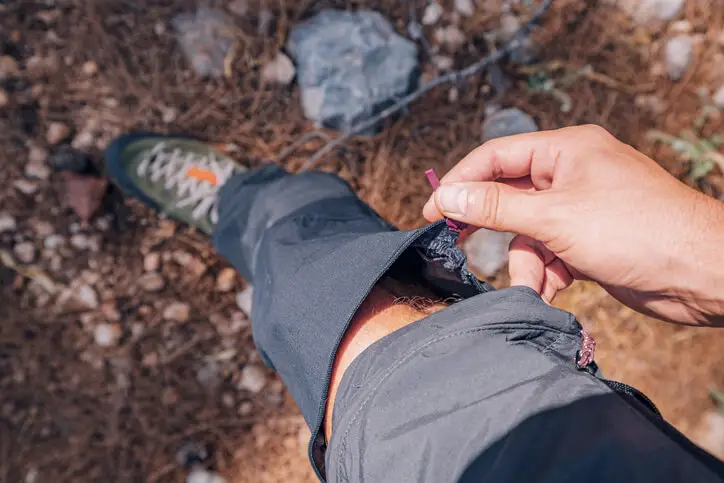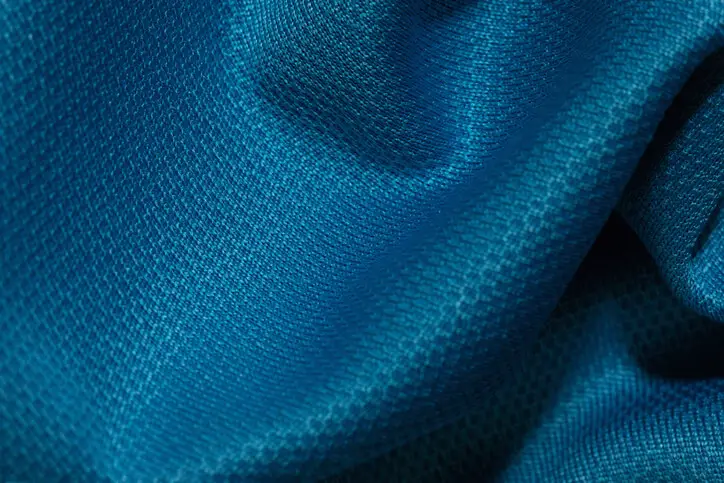When choosing the perfect pair of hiking pants, the debate between nylon and polyester often arises. I've researched both materials to understand better their pros and cons to help fellow hikers make informed decisions. These synthetic fabrics are widely popular due to their durability, lightweight, and moisture-wicking capabilities, making them ideal for outdoor adventures.
My findings showed that nylon and polyester have distinct differences that can affect a hiker's overall experience. For instance, waterproof features play a crucial role when encountering rainfall, and the ability of the fabric to absorb oil and not water can impact odor retention. Considering these factors, personal preference plays a significant role in decision-making.
Throughout this article, I will delve deeper into the properties of nylon and polyester, comparing their strengths and weaknesses and sharing insights based on my hiking experiences. By examining these aspects, I hope to guide fellow outdoor enthusiasts in finding the perfect pair of hiking pants tailored to their needs and preferences.
More...

Nylon vs Polyester Hiking Pants - What are the main differences?
When it comes to hiking pants, choosing the right material is crucial to ensure comfort and durability. The two most common materials used for hiking pants are nylon and polyester. I have discovered that there are some key differences between these materials.
First, nylon is generally stronger than polyester. This means that nylon hiking pants tend to have a higher resistance to abrasion and tearing, making them more durable in challenging outdoor conditions. However, polyester is more heat-resistant, making it a better option for hot environments or high-intensity activities.
In terms of water resistance, polyester has an edge over nylon. As polyester is more hydrophobic, it repels water more efficiently than nylon, which can be advantageous when hiking in wet conditions. On the other hand, nylon dries faster once it gets wet, which can be an essential factor for those who prefer a quick-drying fabric.
Another significant difference between the two materials is their ability to retain odor. Polyester fabric is oleophilic, which absorbs oils more effectively than water, causing it to retain odors more than nylon. This makes nylon preferable for multi-day hikes, where odor control can make a big difference in comfort.
In terms of appearance, nylon fabric often appears brighter and feels softer than polyester, while polyester has a rougher texture. However, this may not be a deciding factor for many hikers, as functionality usually precedes appearance in outdoor gear.
Lastly, when it comes to cost, polyester is often less expensive to produce than nylon, making polyester hiking pants a more budget-friendly option.
In conclusion, the main differences between nylon and polyester hiking pants involve strength, water resistance, odor retention, texture, and cost. Each material has pros and cons, and the choice ultimately depends on personal preference, specific requirements for the hiking environment, and budget.
Nylon vs Polyester Hiking Pants - Durability
When it comes to durability, there are some key differences between nylon and polyester hiking pants that I'd like to discuss. First, let's talk about the fabric strength. Nylon is known for being exceptionally strong, even stronger than polyester, making it a popular choice for hiking pants that withstand various outdoor elements and activities1.
Another aspect to consider is abrasion resistance. Both nylon and polyester are resistant to damage from most chemicals but differ in resistance against wear and tear. Although both materials are quite durable, I've found that nylon is typically more resistant to abrasion, making it better suited for rugged hiking conditions.
There are some noticeable differences in resistance against water and oil. Polyester is more water-resistant, which can be an advantage in wet conditions. However, nylon has the upper hand regarding oil resistance, as it doesn't absorb oil like polyester. This resistance can help prevent the fabric from attracting and retaining body odors, which are oil-based.
Despite their differences, nylon and polyester hiking pants can offer great durability. The right choice for you will depend on your specific needs, personal preferences, and the conditions you anticipate facing during your outdoor adventures.
Nylon vs Polyester Hiking Pants - Water resistance?
I found that nylon and polyester have their own merits regarding water resistance. Nylon is known to be more water-resistant than polyester, mainly due to its tightly woven structure and less absorbent properties. Nylon only absorbs about 3-4% of water. On the other hand, polyester is hydrophobic, meaning it does not absorb water at all. However, this advantage can be somewhat negated when the polyester is woven into a garment.
Durable water repellent (DWR) finishes are often applied to nylon and polyester hiking pants to improve their water resistance further. These coatings help repel water, making the pants more suitable for wet conditions and environments. However, the effectiveness of a DWR finish can depend on the quality and frequency of reapplication.
Although both materials have advantages, I have found that overall, nylon hiking pants provide better water resistance than polyester hiking pants. This is mainly because of nylon's innate properties and ability to maintain water resistance even when the DWR finish starts to wear off.
Additionally, nylon pants generally dry faster than polyester pants after getting wet, which can be essential for hikers who may encounter unpredictable weather on their adventures. The quick-drying properties also help minimize any discomfort or potential hypothermia risks.
In summary, regarding water resistance, I prefer nylon hiking pants over polyester ones due to their superior performance in wet conditions.
Polyester Vs Nylon For Hiking
When it comes to hiking pants, I always consider the material they're made of. Choosing between polyester and nylon is an important decision affecting my comfort, performance, and enjoyment of outdoor adventures. Knowing the pros and cons of both materials can significantly help in making the right choice.
Starting with polyester, it's a popular fabric for hiking pants because it's lightweight, durable, and quick-drying. It does an excellent job of wicking moisture away from my skin, keeping me dry and comfortable on the trail. Polyester is also oleophilic, which means it absorbs oil but not water, making it less susceptible to odor build-up. This can be a huge advantage when I need my hiking gear to stay fresh for multiple days.
On the other hand, nylon is also lightweight and durable but slightly more water-resistant than polyester, which can be beneficial in wet conditions. Nylon hiking pants often have a smoother feel and are more stretchable, providing increased flexibility and freedom of movement on the trail. However, they may not be as effective as polyester at managing moisture and odors.
Both materials have their unique advantages. While polyester excels at moisture-wicking and odor control, nylon offers added water resistance and flexibility. My choice between the two depends on the specific activities and weather conditions I'll encounter on my hike.
In conclusion, selecting the right material for hiking pants can significantly impact my comfort and overall experience on the trail. Understanding the differences between polyester and nylon and assessing which best suits my needs is key to making an informed decision.

Which is more breathable for hiking: nylon or polyester?
Regarding breathability during hikes, I found that both nylon and polyester offer advantages for activewear. Nylon and polyester are synthetic materials that can wick moisture and dry quickly. Although their breathability can vary based on the yarn size and knit or weave they are made from, both materials are generally known for their moisture-wicking properties.
In my experience, I've found that nylon hiking pants can be a better choice for reducing odors. This is because they absorb a little moisture, around 3-4%, which helps mitigate the buildup of unpleasant smells LightHeart Gear. On the other hand, polyester is hydrophobic, which means it won't absorb water and can contribute to a stronger odor.
While both materials offer good breathability, it's important to consider other factors that contribute to a comfortable hiking experience. Comfort and flexibility should also play a role in choosing the best material for hiking, so opt for moisture-wicking and flexible materials when selecting the perfect pair of pants for your outdoor adventures.
So when choosing between nylon and polyester hiking pants, I would consider breathability, comfort, flexibility, and odor resistance. The key is finding the right balance between all these factors to ensure an enjoyable and worry-free hiking experience.
Hiking Pants Material
When choosing the right material for hiking pants, I often debate between nylon and polyester. They're synthetic fabrics commonly used in hiking pants due to their durability and lightweight properties.
In my experience, nylon pants offer excellent abrasion resistance and are generally more durable than polyester pants, which is crucial when hiking rough terrains with rocks and brushes. Nylon pants have also been lauded for their quick-drying capabilities, which prevent chills and discomfort when hiking in wet conditions or sweating during strenuous activities on the trail.
On the other hand, polyester hiking pants have some advantages, such as their ability to wick moisture away from the skin. This moisture-wicking property makes polyester pants ideal for hiking in hot or humid environments since they help keep me dry and comfortable. However, one drawback of polyester is that it tends to retain body odor due to its oleophilic nature, as it absorbs oil rather than water.
Another aspect to consider when choosing between nylon and polyester hiking pants is their environmental impact. While neither material is entirely eco-friendly, nylon is slightly more harmful due to its non-biodegradable nature, and it consumes more energy during production than polyester.
In conclusion, when selecting hiking pants, I need to consider factors such as durability, moisture-wicking, odor retention, and environmental impact, which can help me decide between nylon and polyester hiking pants. Ultimately, the choice depends on individual preferences and the specific needs of a hiker, which may vary depending on the terrain, weather, and hiking conditions.

Evaluating Polyester Pants
In my experience, there are several key factors to consider when evaluating for hiking. One of the main advantages of polyester is its hydrophobic properties. This means that polyester does not absorb any water, making it a great option for wet conditions and preventing hiker's skin from staying damp for too long.
Another benefit of polyester hiking pants is their lightweight nature. Polyester fabrics tend to be lighter than their nylon counterparts, making them a suitable choice for those looking to reduce the weight of their hiking attire. Furthermore, polyester is known for its durability, which means that I can expect my hiking pants to last longer and withstand wear and tear from various terrains.
When assessing the comfort of polyester hiking pants, I have found that they are generally breathable and efficient at wicking moisture away from the skin. This is particularly important on hot days or during strenuous hikes, as it helps maintain a comfortable temperature and keeps me feeling refreshed.
However, certain aspects of polyester aren't ideal for every hiker. Some hikers might find that polyester pants can become uncomfortable over time due to the fabric potentially irritating. Also, polyester materials are more prone to retaining odors, which might be undesirable for multi-day hikes or for those sensitive to smells.
It is also important to consider the additional features in polyester hiking pants, such as the number of pockets, the presence of ventilation zippers, and the adjustability of the waistband and cuffs. These extra features can positively impact the overall functionality of the pants and enhance the hiking experience.
In conclusion, while evaluating polyester hiking pants, I find it crucial to weigh the benefits of the material, such as its water resistance, lightweight properties, and durability, against the potential drawbacks, including comfort, odor retention, and additional features. Ultimately, personal preferences and specific needs will determine the suitability of polyester pants for each hiker.
Evaluating Nylon Pants
In my experience, nylon hiking pants have several advantages that make them popular for outdoor enthusiasts. One benefit of nylon is its water resistance. This material is naturally water-resistant, so I can stay relatively dry even in damp conditions when I wear nylon hiking pants during my adventures.
Another great feature of nylon is its lightweight nature. When I carry my hiking gear, weight is always a concern. Fortunately, nylon hiking pants tend to weigh less than their polyester counterparts. This difference means less fatigue on long hikes and easier packing for me.
As a hiker, I appreciate the durability of nylon pants. They are generally more resistant to wear and tear compared to other fabrics. This strength ensures that my investment in hiking gear lasts for multiple seasons and adventures.
In terms of comfort, I find that nylon pants offer good breathability. This quality allows me to stay cool throughout my hikes, even in warmer climates. Moreover, nylon pants often have a nice stretch, enhancing mobility during hikes.
However, there are some drawbacks to consider as well. Nylon tends to retain odors more than polyester. After a few days of hiking, my nylon pants can become quite smelly, which is a downside compared to polyester alternatives.
In summary, nylon hiking pants have excellent benefits such as water resistance, lightweight construction, durability, and comfort. However, odor retention can be a potential issue for some hikers.

Best Clothing Material For Hiking
In my experience, the best clothing material for hiking largely depends on personal preferences and specific environmental conditions. However, there are two popular materials for hiking pants - nylon and polyester. Let me share some insights on both materials to help you choose the best hiking adventure.
Nylon is durable and lightweight, making it an ideal choice for hiking pants. It has excellent abrasion resistance, so I don’t have to worry about my pants wearing out quickly when hiking through rough terrain. One major advantage of nylon is its quick-drying property. I find it extremely useful when I encounter unexpected rain or need to cross a stream. However, nylon tends to be less breathable than polyester, which could be a downside when hiking in warmer climates.
On the other hand, polyester is another great option for hiking pants. It is also lightweight, durable, and moisture-wicking, which helps to keep me dry and comfortable on the trail. Polyester pants are generally more breathable than their nylon counterparts, making them better for hot-weather hiking. An interesting fact about polyester is that it has an oleophilic nature, meaning it absorbs oil rather than water. Due to this characteristic, polyester pants may help reduce odors after a long, sweaty hike.
Ultimately, choosing between nylon and polyester hiking pants comes down to personal preferences and the specific conditions of your hike. I'd go for nylon pants if I'm hiking in a wet or humid environment because of their quick-drying properties. On the other hand, if I plan to hike in hot and dry conditions, I'd choose polyester pants for their breathability. Regardless of the material, look for additional features like waterproofing and moisture-wicking abilities for a more comfortable hiking experience.
- Are Merrell Shoes Good? – An Unbiased Review of Merrell Footwear - December 9, 2023
- Where Are Merrell Shoes Made? - December 9, 2023
- Camping in 40-degree Weather: Tips and Tricks - September 25, 2023





![Columbia vs Patagonia vs North Face [Comparison Guide] Columbia vs Patagonia vs North Face [Comparison Guide]](https://grandcircletrails.com/wp-content/uploads/2022/05/hiking-in-the-nature-1-150x150.jpg)
